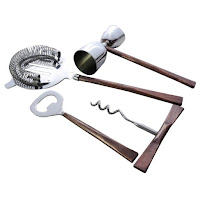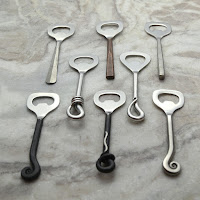Corkscrews and wine bottle openers are a vital
component of any foodservice operation or establishment that is seeking to
serve wine to their customers. Such tools may appear as a simple object as they
serve one purpose. Yet, they are available for serving several purposes and the
consumer’s choice varies frequently.
In this blog, we are going to learn different
aspects of a wine bottle opener
and what you need to consider while buying one.
Anatomy of a
Corkscrew
There are several styles and types of wine bottle
openers. Regardless of their differences in designs and making, openers
generally at least have a corkscrew worm, handle, and boot lever to remove
corks. Other features such as bottle cap removers and foil cutters are also
common features found on a few corkscrew styles.
Let’s find out what they are:
●
Corkscrew worm: It is typically a
single metal helix that drives into the cork of the wine for removing it from
the bottle. The helix clutches the cork as it is rotated in so that the cork
can be easily and completely removed from the wine bottle.
●
Foil cutter: It is generally
a small and serrated blade or wheel that is used for slice opening the
protective foil covering at the top of the wine bottle.
●
Corkscrew handle: It offers the
necessary grip and leverage required for removing corks from the wine bottles.
Handle lengths, styles, and materials vary largely across the various types of
corkscrews.
●
Corkscrew boot
lever: Ir offers extra leverage to remove off the wine cork out of the wine
bottles. These are essentially discovered on waiter's corkscrews.
●
Bottlecap
remover: It transforms a wine bottle opener from simply being capable of
opening a wine bottle to popping the tops off soda or beer bottles. Bottlecap
removers are built on several types of corkscrews.
What to Consider
When Purchasing a Corkscrew
Before you plan to buy a wine bottle opener for
yourself or for giving it away as a gift, you must consider a few things as
described below:
Ease of Use
The first and most important thing to consider at
the time of purchasing a wine bottle opener or corkscrew is the ease of use. A
wine opener that is difficult to use may result in broken corks, cork crumbs in
the drink, or you might end up unable to move off the cork off the bottle. Due
to this reason, many large establishments or operations have shifted towards
the electric corkscrews, wall mount, or counter mount as these designs make the
process of cork removal incredibly easy and simple for everyone.
Cork Type
Distinct varieties of corkscrews specialize in
removing different types of cork. To begin with, there are mainly two kinds of
wine corks: natural and synthetic cork. Synthetic corks are the ones that are
denser than natural corks that require more force in twisting the worm into the
cork. The most significant aspect of a synthetic cork is that it is less likely
to break apart while extraction. On the other hand, natural corks are more
sensitive and brittle to removal when compared to synthetic. The benefit of
natural cork is that it properly age wines stored over a long time period.
Cost
Smaller establishments or operation with staff
trained in opening wine cork or sommeliers may prefer to pick a waiter’s or
pocket corkscrew. Generally, these corkscrews are less expensive than other
openers and are inexpensive to be replaced. Large, high-volume establishments
should prefer the more expensive counter mount, wall mount, and electric
corkscrews. It is so because these designs make the opening of bottles easier
and quicker which is helping in recouping their cost in saved labor.
Size
Corkscrews come in different sizes. However,
smaller corkscrews that are also called waiter’s or pocket corkscrews are
considered an ideal choice for staff on the move. Such openers are easy to fit
inside a pants pocket or an apron. Plus, they are lightweight. In contrast,
larger corkscrews like counter mount, electric, and wall mount corkscrews are
suitable for a single location where the staff carries wine bottles for opening
them. Often, these larger wine bottle openers are easier and faster to use as compared
to smaller corkscrews.
Types of
Corkscrew or Wine Bottle Opener
There are several types of wine bottle and beer
bottle opener. Each of them has different advantages and varies in the
way they are used to remove the cork from the bottle. Below, we have described
distinct varieties of corkscrews:
●
Waiter’s Corkscrew
●
Pocket Corkscrew
●
Wing Corkscrew
●
Electric Corkscrew
●
Counter Mount Corkscrews
●
Lever Corkscrews
●
Wine Cork Extractors
●
Wall Mount Corkscrews
●
Continuous Pull Corkscrews
How to Use a
Waiter's Corkscrew?
Waiter’s corkscrew is also known as the wine key
and is considered the standard tool by most food establishments. They provide
the perfect combination of functionality, affordability, and compact size.
Further, such an opener is considered the oldest form of opening a wine bottle.
Since the Waiter’s Corkscrew is the most popular one used by both the waiter
and most people, so here we are going to describe the steps to use it:
Step 1: You should begin
by cutting the foil under the bottle’s lip.
Step 2: Once you have
cut the foil, remove it from the neck of the bottle.
Step 3: Now, you are
supposed to place the worm in the center of the cork. Then, you need to twist
the corkscrew so that the worm gets inserted into the cork completely.
Step 4: The next you need
to place the first, small boot lever notch on the bottle’s lip and hold it in
place.
Step 5: Then, in order to
pull the cork almost halfway out of the bottle, lever the handle up.
Step 6: The next you
need to move the second boot lever notch to the bottle’s tip. Then, pull the
cork off the rest the way out of the bottle.
Step 7: Ultimately, to remove the cork from the
worm, you need to follow the process in the reverse motion while holding onto
the cork.



No comments:
Post a Comment